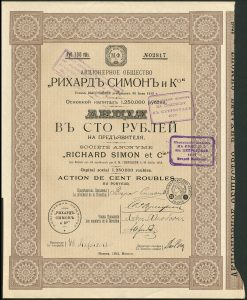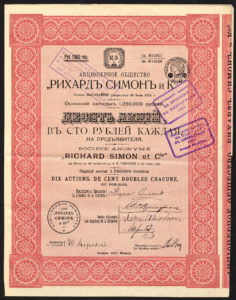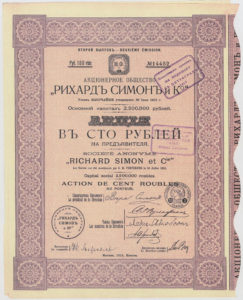
Société Anonyme “Richard Simon et Cie”
Акционерное Общество “Рихардъ Симонъ и Ко.”
Other city spellings: Moscou, Moskau
Formed in 1912 with head office in Moscow. Initial capital was 1,250,000 roubles in shares of 100 roubles, increased in 1914 to 2,500,000 roubles in shares of 100 roubles.
1912
Description
In the business directory of 1909, the company is referred to as a cloth factory. Richard Simon & Co. produced woolen and cotton headscarves, shawls, handkerchiefs, tablecloths. The manufactory was originally founded by the Moscow merchant Ivanov in 1879. In the early years, the workshop had around 15 workers. Richard Simon took over the company from Ivanov around the turn of the century. In 1907, 200 people worked there in two shifts and the turnover was about 1,400,000 rubles. By the First World War, the number of employees had increased again to 300.
In order to acquire the capital for further modernization and expansion of the factory, Richard Simon founded the joint stock company “Richard Simon & Co.” in 1912 with a capital of 1,250,000 rubles. This share is signed by Vera Andreevna Simon. It is likely that her husband Richard had already passed away at the time the share certificate was issued. The factory manager Max Jakobson, the technical manager F.G. Wulfson and commercial manager A. Arendt signed the share. After the transformation into joint stock company, the expansion and modernization of production began.
Knitwear production was started in a new five-storey building, which was equipped with new knitting and warp-knitting machines. New “Singer” sewing machines were used. Simon now switched from sewing simple cloths to ready-made clothing. Due to the First World War, Richard Simon & Co. delivered linen and clothing for the soldiers at the front, for which the machine park was further expanded and 400 more seamstresses were hired. With the end of the war and the communist revolution, the company was nationalized as “Ismailovskaja Trikotazhnaja Fabrika”, later renamed “Beautiful Dawn”. Production only suffered from the civil war for a few years, because by the mid-1920s the number of workers had already risen to 1,500. The “Beautiful Dawn” developed into a leading Soviet producer of knitted outerwear and underwear. After the collapse of the Soviet era, the factory was privatized again. She kept her name “Beautiful Dawn”. Anyone interested in today’s company can find out more at www.krasnayazarya.ru. (Source: Eric Meyer; HWPH April 2017)



